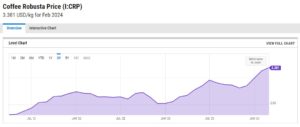
In recent times, coffee lovers around the world have been noticing a gradual increase in the price of their favourite beverage. This trend can be attributed to a complex interplay of factors, ranging from agricultural practices to geopolitical tensions. In this blog post, we’ll delve into these reasons, highlighting how they contribute to the rising costs of coffee. Coffee Robusta Price is at a current level of 3.381, up from 3.264 last month and up from 2.291 one year ago. This is a change of 3.59% from last month and 47.57% from one year ago
The Harvest and Market Dynamics
Vietnam, a key player in the robusta coffee market, is seeing a successful harvest season. As the Tet New Year holidays approach, a time marked by increased commercial activity and selling, we can expect some fluctuations in coffee stock availability. However, the overall commercial activity within Vietnam is likely to slow down as we move closer to the holidays.
Brazil’s Coffee Crop and Weather Concerns
Brazil, another major coffee producer, is now focusing on the development of its new crop. The upcoming 2024 harvest is anticipated with great interest, as forecasts and weather conditions will play a significant role in determining the production potential. Brazil’s export performance has shown considerable improvement, which, under normal circumstances, could stabilize prices. However, the weather remains a critical factor that could affect the supply chain and pricing.
Logistics and Geopolitical Tensions
A significant factor contributing to the rise in coffee prices is the current state of global logistics. Major shipping lines are rerouting their vessels via the Cape of Good Hope due to geopolitical tensions and security concerns in the Red Sea and Suez Canal. This rerouting adds to the lead times and costs of moving goods, including coffee. The Suez Canal, facilitating a third of global container ship cargo, plays a crucial role in the timely and cost-effective transportation of coffee. Disruptions here could have ripple effects, potentially leading to global inflation.
Certified Coffee Stocks and Market Sentiments
The stability of certified washed Arabica coffee stocks and the distribution of these stocks between Europe and the USA reflect a tightly controlled supply chain. However, any fluctuation in these stocks or in the logistics of transporting coffee can have immediate effects on prices.
The Bottom Line
The rise in coffee prices is not attributed to a single cause but is the result of a combination of agricultural, logistical, and geopolitical factors. From Vietnam’s harvest dynamics to Brazil’s weather conditions and the impact of global shipping routes, each element plays a part in shaping the market. As we continue to navigate through these complex dynamics, one thing remains clear: the world of coffee is as interconnected as it is diverse, with each change in the supply chain having a direct impact on coffee lovers worldwide.
In summary, while coffee enthusiasts might have to pay a bit more for their beloved brew, understanding the reasons behind these price hikes can help us appreciate the global journey coffee takes to reach our cups.

